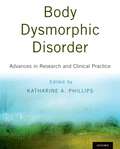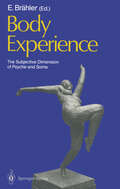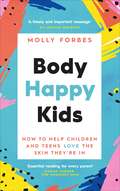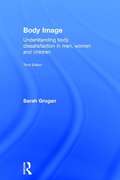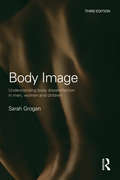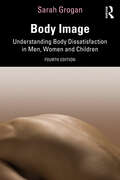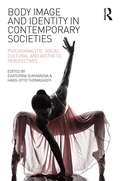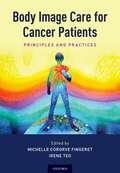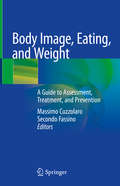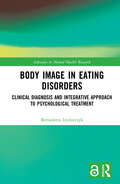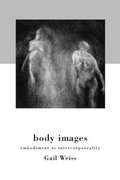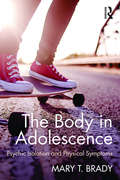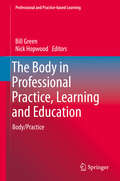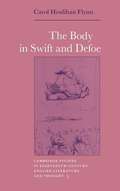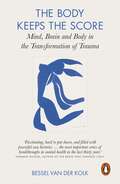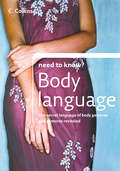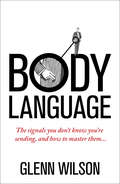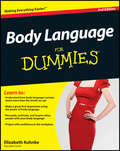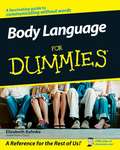- Table View
- List View
Body Dysmorphic Disorder: Advances in Research and Clinical Practice
This landmark book is the first comprehensive edited volume on body dysmorphic disorder (BDD), a common and severe disorder. People with BDD are preoccupied with distressing or impairing preoccupations with non-existent or slight defects in their physical appearance. People with BDD think that they look ugly -- even monstrous -- although they look normal to others. BDD often derails sufferers' lives and can lead to suicide. BDD has been described around the world since the 1800s but was virtually unknown and unstudied until only several decades ago. Since then, research on BDD has dramatically increased understanding of this often-debilitating condition. Only recently, BDD was considered untreatable, but today, most sufferers can be successfully treated. This is the only book that provides comprehensive, in-depth, up-to-date information on BDD's clinical features, history, classification, epidemiology, morbidity, features in special populations, diagnosis and assessment, etiology and pathophysiology, treatment, and relationship to other disorders. Numerous chapters focus on cosmetic treatment, because it is frequently received but usually ineffective for BDD, which can lead to legal action and even violence toward treating clinicians. The book includes numerous clinical cases, which illustrate BDD's clinical features, its often-profound consequences, and recommended treatment approaches. This volume's contributors are the leading researchers and clinicians in this rapidly expanding field. Editor Katharine A. Phillips, head of the DSM-V committee on BDD, has done pioneering research on many aspects of this disorder, including its treatment. This book will be of interest to all clinicians who provide mental health treatment and to researchers in BDD, anxiety disorders, eating disorders, and other obsessive-compulsive and related disorders. It will be indispensable to surgeons, dermatologists, and other clinicians who provide cosmetic treatment. Students and trainees with an interest in psychology and mental health will also be interested in this book. This book fills a major gap in the literature by providing clinicians and researchers with cutting-edge, indispensable information on all aspects of BDD and its treatment.
Body Experience: The Subjective Dimension of Psyche and Soma Contributions to Psychosomatic Medicine
by H. Appelt H. Becker P. Bernhard D. Bongers Elmar Brähler W. Dahlmann H. C. Deter P. Diederichs R. Ernst H. Felder U. Gieler W. Hettich C. Heintze-Hook M. Jarka P. Joraschky M. Lohs P. Möhring H. Müller-Braunschweig A. Otten B. Strauß P. M. WiedemannIn this book body experience is seen as the subjective expression of psyche and soma and is discussed in relation to its significance in modern medical practice and psychoanalysis. The authors relate how the patient's subjective expression of his or her body frequently plays only a marginal role in current therapy and how the central factor of many diseases is consequently missed. Particularly in the growing field of psychoanalytic psychosomatic medicine it will be necessary to pay the issue of body experience more attention. These theoretical and empirical contributions on body experience were specially prepared for the volume. Initial chapters cover a variety of aspects of body experience and its general significance in medicine and psychoanalysis. Following chapters consider body-oriented forms of therapy, sex-related aspects of body experience and the empirical measurement of body experience and bodily complaints.
Body Happy Kids: How to help children and teens love the skin they’re in
by Molly ForbesWe are not born hating our bodies. Make sure your kids never do.No parent wants their child to grow up with anything less than wholehearted confidence in themselves. Sadly research shows that children as young as five are saying they need to 'go on a diet' and over half of 11 to 16-year-olds regularly worry about the way they look. Campaigner and mum-of-two-girls Molly Forbes is here to help.In Body Happy Kids, Molly draws on her own experience and a range of experts to provide parents with a much-needed antidote to the confusing health advice that bombards us every day. This reassuring and practical guide covers everything you need to help your child to care for their body with kindness, including how to approach good nutrition (without falling for diet culture), how to see the reality behind beauty ideals and how social media can be used to support body confidence rather than destroy it. With Molly's help, you can arm yourself with the insight and tools to raise resilient children who love the skin they're in.
Body Image: Understanding Body Dissatisfaction In Men, Women And Children (PDF)
by Sarah GroganBody Imageprovides a comprehensive summary of research on body image in men, women, and children drawing together research findings from the fields of psychology, sociology, clothing, and gender studies. This third edition has been thoroughly revised and updated to reflect the significant increase in research on body image since the previous edition, as well as the significant cultural changes in how men's and women's bodies are viewed. Data are also included from interviews and focus groups with men, women, and children who have spoken about their experiences of body image and body dissatisfaction, producing a comprehensive understanding of how men and women construct and understand their bodies in the twenty-first century. The only sole-authored text to provide a comprehensive view of body image research, focusing on men, women, and children, Body Imagewill be invaluable to students and researchers, as well as practitioners with an interest in body image and how to reduce body dissatisfaction.
Body Image: Understanding Body Dissatisfaction in Men, Women and Children
by Sarah GroganBody Image provides a comprehensive summary of research on body image in men, women, and children drawing together research findings from the fields of psychology, sociology, clothing, and gender studies. This third edition has been thoroughly revised and updated to reflect the significant increase in research on body image since the previous edition, as well as the significant cultural changes in how men’s and women’s bodies are viewed. Data are also included from interviews and focus groups with men, women, and children who have spoken about their experiences of body image and body dissatisfaction, producing a comprehensive understanding of how men and women construct and understand their bodies in the twenty-first century. The only sole-authored text to provide a comprehensive view of body image research, focusing on men, women, and children, Body Image will be invaluable to students and researchers, as well as practitioners with an interest in body image and how to reduce body dissatisfaction.
Body Image: Understanding Body Dissatisfaction in Men, Women and Children
by Sarah GroganBody Image provides a comprehensive summary of research on body image in men, women, and children drawing together research findings from the fields of psychology, sociology, clothing, and gender studies. This third edition has been thoroughly revised and updated to reflect the significant increase in research on body image since the previous edition, as well as the significant cultural changes in how men’s and women’s bodies are viewed. Data are also included from interviews and focus groups with men, women, and children who have spoken about their experiences of body image and body dissatisfaction, producing a comprehensive understanding of how men and women construct and understand their bodies in the twenty-first century. The only sole-authored text to provide a comprehensive view of body image research, focusing on men, women, and children, Body Image will be invaluable to students and researchers, as well as practitioners with an interest in body image and how to reduce body dissatisfaction.
Body Image: Understanding Body Dissatisfaction in Men, Women and Children
by Sarah GroganFully revised and updated, Body Image 4th Edition provides a comprehensive summary of research on body image in men, women, and children drawing together research findings from the fields of psychology, sociology, and gender studies. The new edition presents all the latest research on body image including work on technology and body image, interventions to reduce body dissatisfaction, and links between body image, BMI, and clothing availability. Including data from interviews and focus groups with men, women, and children who have spoken about body image and its impact on the rest of their lives, the book explores a range of important contemporary issues, including the effects of social media and selfie-taking on body image, the work of activists and academics who are trying to change how the fashion industry presents women’s bodies, and new work investigating impacts of whole-body scanning technology and game-play avatars on appearance concern. Reflecting the direction of research on body image from a range of disciplines since the previous edition, the book also includes an increased focus on body image in men, looking at studies on pressures to be more muscular and toned, and evaluating the possible impacts on health-related behaviors such as exercise and body-related drug use. The only sole-authored text in the field, and integrating work from several disciplines, this is essential reading for students and researchers in psychology, sociology, computing science, sport and exercise science, and gender studies, with an interest in reducing body dissatisfaction in men, women and children.
Body Image: Understanding Body Dissatisfaction in Men, Women and Children
by Sarah GroganFully revised and updated, Body Image 4th Edition provides a comprehensive summary of research on body image in men, women, and children drawing together research findings from the fields of psychology, sociology, and gender studies. The new edition presents all the latest research on body image including work on technology and body image, interventions to reduce body dissatisfaction, and links between body image, BMI, and clothing availability. Including data from interviews and focus groups with men, women, and children who have spoken about body image and its impact on the rest of their lives, the book explores a range of important contemporary issues, including the effects of social media and selfie-taking on body image, the work of activists and academics who are trying to change how the fashion industry presents women’s bodies, and new work investigating impacts of whole-body scanning technology and game-play avatars on appearance concern. Reflecting the direction of research on body image from a range of disciplines since the previous edition, the book also includes an increased focus on body image in men, looking at studies on pressures to be more muscular and toned, and evaluating the possible impacts on health-related behaviors such as exercise and body-related drug use. The only sole-authored text in the field, and integrating work from several disciplines, this is essential reading for students and researchers in psychology, sociology, computing science, sport and exercise science, and gender studies, with an interest in reducing body dissatisfaction in men, women and children.
Body Image and Identity in Contemporary Societies: Psychoanalytic, social, cultural and aesthetic perspectives
by Ekaterina Sukhanova Hans-Otto ThomashoffPopular interest in body image issues has grown dramatically in recent years, due to an emphasis on individual responsibility and self-determination in contemporary society as well as the seemingly limitless capacities of modern medicine; however body image as a separate field of academic inquiry is still relatively young. The contributors of Body Image and Identity in Contemporary Societies explore the complex social, political and aesthetic interconnections between body image and identity. It is an in-depth study that allows for new perspectives in the analysis of contemporary visual art and literature but also reflects on how these social constructs inform clinical treatment. Sukhanova and Thomashoff bring together contributions from psychoanalysts, psychotherapists, psychiatrists and scholars in the fields of the social sciences and the humanities to explore representations of the body in literature and the arts across different times and cultures. The chapters analyse the social construction of the 'ideal' body in terms of beauty, gender, sexuality, race, ethnicity, class and disability, from a broadly psychoanalytic perspective, and traces the mechanisms which define the role of the physical appearance in the formation of identity and the assumption of social roles. Body Image and Identity in Contemporary Societies' unique interdisciplinary outlook aims to bridge the current gap between clinical observations and research in semiotic theory. It will be of interest to psychoanalysts, psychotherapists, art therapists, art theorists, academics in the humanities and social sciences, and those interested in an interdisciplinary approach to the issues of body image and identity. Ekaterina Sukhanova is University Director of Academic Program Review at the City University of New York USA. She serves as Scientific Secretary of the Section for Art and Psychiatry and the Section of Art and Psychiatry of the World Psychiatric Association. She is also engaged in interdisciplinary research on cultural constructs of mental health and illness and curates exhibits of art brut as a vehicle for fighting stigma. Hans-Otto Thomashoff was born in Germany and lives in Vienna. He is a psychiatrist, psychoanalyst, art historian and author of fiction and non-fiction books. He has been curator of several art exhibitions highlighting the connection between the psyche and art as well as president of the section of Art and Psychiatry of the World Psychiatric Association and advisory committee member of the Sigmund Freud Foundation, Vienna.
Body Image and Identity in Contemporary Societies: Psychoanalytic, social, cultural and aesthetic perspectives
by Ekaterina Sukhanova Hans-Otto ThomashoffPopular interest in body image issues has grown dramatically in recent years, due to an emphasis on individual responsibility and self-determination in contemporary society as well as the seemingly limitless capacities of modern medicine; however body image as a separate field of academic inquiry is still relatively young. The contributors of Body Image and Identity in Contemporary Societies explore the complex social, political and aesthetic interconnections between body image and identity. It is an in-depth study that allows for new perspectives in the analysis of contemporary visual art and literature but also reflects on how these social constructs inform clinical treatment. Sukhanova and Thomashoff bring together contributions from psychoanalysts, psychotherapists, psychiatrists and scholars in the fields of the social sciences and the humanities to explore representations of the body in literature and the arts across different times and cultures. The chapters analyse the social construction of the 'ideal' body in terms of beauty, gender, sexuality, race, ethnicity, class and disability, from a broadly psychoanalytic perspective, and traces the mechanisms which define the role of the physical appearance in the formation of identity and the assumption of social roles. Body Image and Identity in Contemporary Societies' unique interdisciplinary outlook aims to bridge the current gap between clinical observations and research in semiotic theory. It will be of interest to psychoanalysts, psychotherapists, art therapists, art theorists, academics in the humanities and social sciences, and those interested in an interdisciplinary approach to the issues of body image and identity. Ekaterina Sukhanova is University Director of Academic Program Review at the City University of New York USA. She serves as Scientific Secretary of the Section for Art and Psychiatry and the Section of Art and Psychiatry of the World Psychiatric Association. She is also engaged in interdisciplinary research on cultural constructs of mental health and illness and curates exhibits of art brut as a vehicle for fighting stigma. Hans-Otto Thomashoff was born in Germany and lives in Vienna. He is a psychiatrist, psychoanalyst, art historian and author of fiction and non-fiction books. He has been curator of several art exhibitions highlighting the connection between the psyche and art as well as president of the section of Art and Psychiatry of the World Psychiatric Association and advisory committee member of the Sigmund Freud Foundation, Vienna.
Body Image Care for Cancer Patients: Principles and Practice
by Michelle Cororve Fingeret and Irene TeoThis book is the first and only academic textbook of principles and practices of body image care for cancer patients, designed to target a multidisciplinary audience of healthcare care professionals engaged in the science and/or practice of psychosocial oncology internationally. Content is primarily geared toward mental health professionals or those involved in supportive care of cancer patients, but is broadly applicable to all members of the oncologic healthcare team. Best practices and models of body image care are reviewed and presented in such a manner as to be directly relevant to oncologists, psychiatrists, psychologists, nurses, social workers, rehabilitation specialists, speech and language pathologists, and other allied healthcare professionals. Body Image Care for Cancer Patients provides a 7omprehensive overview of available literature on body image outcomes with cancer populations, and integrates scientific findings from the general body image literature that can be applied to the oncology setting. Readers are provided with a comprehensive theoretical foundation along with practical recommendations for assessment tools and intervention approaches that can be utilized by a range of healthcare professionals. Case examples are incorporated throughout the textbook considering different aspects of disease and treatment, and are written from the perspective of different professional disciplines. This book will be relevant for emerging as well as established healthcare professionals internationally, and can be used in training and other educational settings. This book is unique as there is no current academic text focusing on advancing the science and practice of body image care for cancer patients. Other reference texts have broadly focused on reviewing body image theory and findings in the general population or across a broad spectrum of medical illness. The time has come for a more focused textbook specific to body image and cancer that can significantly benefit the field of oncology.
Body Image Care for Cancer Patients: Principles and Practice
This book is the first and only academic textbook of principles and practices of body image care for cancer patients, designed to target a multidisciplinary audience of healthcare care professionals engaged in the science and/or practice of psychosocial oncology internationally. Content is primarily geared toward mental health professionals or those involved in supportive care of cancer patients, but is broadly applicable to all members of the oncologic healthcare team. Best practices and models of body image care are reviewed and presented in such a manner as to be directly relevant to oncologists, psychiatrists, psychologists, nurses, social workers, rehabilitation specialists, speech and language pathologists, and other allied healthcare professionals. Body Image Care for Cancer Patients provides a 7omprehensive overview of available literature on body image outcomes with cancer populations, and integrates scientific findings from the general body image literature that can be applied to the oncology setting. Readers are provided with a comprehensive theoretical foundation along with practical recommendations for assessment tools and intervention approaches that can be utilized by a range of healthcare professionals. Case examples are incorporated throughout the textbook considering different aspects of disease and treatment, and are written from the perspective of different professional disciplines. This book will be relevant for emerging as well as established healthcare professionals internationally, and can be used in training and other educational settings. This book is unique as there is no current academic text focusing on advancing the science and practice of body image care for cancer patients. Other reference texts have broadly focused on reviewing body image theory and findings in the general population or across a broad spectrum of medical illness. The time has come for a more focused textbook specific to body image and cancer that can significantly benefit the field of oncology.
Body Image, Eating, and Weight: A Guide To Assessment, Treatment, And Prevention
by Massimo Cuzzolaro Secondo FassinoThis book equips readers with the knowledge required to improve diagnosis and treatment and to implement integrated prevention programs in patients with eating and weight disorders. It does so by providing a comprehensive, up-to-date review of research findings and theoretical assumptions concerning the interface and interactions between body image and such disorders as anorexia nervosa, bulimia nervosa, binge eating disorder, other specified feeding and eating disorders, orthorexia nervosa, overweight, and obesity. After consideration of issues of definition and classification, the opening part of the book examines the concept of body image from a variety of viewpoints. A series of chapters are then devoted to the assessment of the multidimensional construct “body image”, to dysmorphophobia/body dysmorphic disorder, and to muscle dysmorphia. The third part discusses body image in people suffering from different eating disorders and/or overweight or obesity, and two final chapters focus on body image in the integrated prevention of eating disorders and obesity, and cultural differences regarding body image. The book will be of interest to all health professionals who work in the fields of psychiatry, clinical psychology, eating disorders, obesity, body image, adolescence, public health, and prevention.
Body Image in Eating Disorders: Clinical Diagnosis and Integrative Approach to Psychological Treatment (Advances in Mental Health Research)
by Bernadetta IzydorczykBody Image in Eating Disorders explores issues relating to the prevention, clinical diagnosis, and psychological treatment of distortions of body image in eating disorders. It presents a multifactorial model of indicators for diagnosis and treatment, considering psychological, sociocultural, and family indicators. Based on original empirical research with women and girls suffering from eating disorders, the book draws attention to limitations and dilemmas related to psychological diagnosis and treatment of people with eating disorders including anorexia readiness syndrome, bulimia, and bigorexia. The book proposes an integrative psychodynamic approach to the diagnosis and treatment of body image disorders and presents case studies illustrating examples of application of integration of psychodynamic therapy and psychodrama in psychological treatment of young people suffering from eating disorders. It considers risk factors including abnormal body image for the development of eating disorders and argues that psychological diagnosis of the body image is an important factor in determining the right direction of psychological treatment for people with eating disorders. Drawing on theoretical foundations and evidence-based clinical practice, the book will be of great interest to researchers, academics, and students in the fields of clinical and applied psychology, mental health, and specialists in eating disorders.
Body Image in Eating Disorders: Clinical Diagnosis and Integrative Approach to Psychological Treatment (Advances in Mental Health Research)
by Bernadetta IzydorczykBody Image in Eating Disorders explores issues relating to the prevention, clinical diagnosis, and psychological treatment of distortions of body image in eating disorders. It presents a multifactorial model of indicators for diagnosis and treatment, considering psychological, sociocultural, and family indicators. Based on original empirical research with women and girls suffering from eating disorders, the book draws attention to limitations and dilemmas related to psychological diagnosis and treatment of people with eating disorders including anorexia readiness syndrome, bulimia, and bigorexia. The book proposes an integrative psychodynamic approach to the diagnosis and treatment of body image disorders and presents case studies illustrating examples of application of integration of psychodynamic therapy and psychodrama in psychological treatment of young people suffering from eating disorders. It considers risk factors including abnormal body image for the development of eating disorders and argues that psychological diagnosis of the body image is an important factor in determining the right direction of psychological treatment for people with eating disorders. Drawing on theoretical foundations and evidence-based clinical practice, the book will be of great interest to researchers, academics, and students in the fields of clinical and applied psychology, mental health, and specialists in eating disorders.
Body Images: Embodiment As Intercorporeality (PDF)
by Gail WeissDrawing on relevant discussions of embodiment in phenomenology, feminist theory, psychoanalytic theory, queer theory and post-colonial theory, Body Imagesexplores the role played by the body image in our everyday existence.
The Body in Adolescence: Psychic Isolation and Physical Symptoms
by Mary BradyThe Body in Adolescence: Psychic Isolation and Physical Symptoms examines the affective experience of psychic isolation as an important and painful element of adolescent development. Mary Brady begins by discussing how psychic isolation, combined with the intensity of adolescent processes, can leave adolescents unable to articulate their experience. She then shows how the therapist can understand and help adolescents whose difficulty with articulation and symbolization can leave them vulnerable to breakdown into physical bodily symptoms. This book introduces fresh ideas about adolescent development in the first chapter. Subsequent chapters include clinical essays involving adolescent patients presenting with bodily expressions such as anorexia, bulimia, cutting, substance abuse, and suicide attempts. Attention is also paid to adolescents’ use of social media in relation to these bodily symptoms – such as their use of on-line ‘pro-ana’ or cutting sites. Clinicians can feel challenged or even stymied when presented with their adolescent patient’s fresh cut or recent episode of binge drinking. Brady uses Bion’s conceptualization of containment and the balance of psychotic versus integrative parts of the personality to examine the emergence of concrete bodily symptoms in adolescence. Throughout, Mary Brady offers ways of understanding and empathically engaging with adolescents. This book is essential reading for psychoanalysts and psychotherapists who treat adolescents and other patients with physical symptoms, as well as other readers with an interest in the psychoanalytic understanding of these issues.
The Body in Adolescence: Psychic Isolation and Physical Symptoms
by Mary BradyThe Body in Adolescence: Psychic Isolation and Physical Symptoms examines the affective experience of psychic isolation as an important and painful element of adolescent development. Mary Brady begins by discussing how psychic isolation, combined with the intensity of adolescent processes, can leave adolescents unable to articulate their experience. She then shows how the therapist can understand and help adolescents whose difficulty with articulation and symbolization can leave them vulnerable to breakdown into physical bodily symptoms. This book introduces fresh ideas about adolescent development in the first chapter. Subsequent chapters include clinical essays involving adolescent patients presenting with bodily expressions such as anorexia, bulimia, cutting, substance abuse, and suicide attempts. Attention is also paid to adolescents’ use of social media in relation to these bodily symptoms – such as their use of on-line ‘pro-ana’ or cutting sites. Clinicians can feel challenged or even stymied when presented with their adolescent patient’s fresh cut or recent episode of binge drinking. Brady uses Bion’s conceptualization of containment and the balance of psychotic versus integrative parts of the personality to examine the emergence of concrete bodily symptoms in adolescence. Throughout, Mary Brady offers ways of understanding and empathically engaging with adolescents. This book is essential reading for psychoanalysts and psychotherapists who treat adolescents and other patients with physical symptoms, as well as other readers with an interest in the psychoanalytic understanding of these issues.
The Body in Professional Practice, Learning and Education: Body/Practice (Professional and Practice-based Learning #11)
by Bill Green Nick HopwoodThe body matters, in practice. How then might we think about the body in our work in and on professional practice, learning and education? What value is there in realising and articulating the notion of the professional practitioner as crucially embodied? Beyond that, what of conceiving of the professional practice field itself as a living corporate body? How is the body implicated in understanding and researching professional practice, learning and education? Body/Practice is an extensive volume dedicated to exploring these and related questions, philosophically and empirically. It constitutes a rare but much needed reframing of scholarship relating to professional practice and its relation with professional learning and professional education more generally. It takes bodies seriously, developing theoretical frameworks, offering detailed analyses from empirical studies, and opening up questions of representation.The book is organized into four parts: I. ‘Introducing the Body in Professional Practice, Learning and Education’; II. ‘Thinking with the Body in Professional Practice’; III. ‘The Body in Question in Health Professional Education and Practice’; IV. ‘Concluding Reflections’. It brings together researchers from a range of disciplinary and professional practice fields, including particular reference to Health and Education. Across fifteen chapters, the authors explore a broad range of issues and challenges with regard to corporeality, practice theory and philosophy, and professional education, providing an innovative, coherent and richly informed account of what it means to bring the body back in, with regard to professional education and beyond.
The Body in Swift and Defoe (PDF)
by Carol Houlihan FlynnThis original book takes a new look at problems surrounding the physical, material nature of the human body, in particular as represented in the works of Jonathan Swift and Daniel Defoe. It examines the role that literary invention (with its rhetorical and linguistic strategies) plays in expressing and exploring the problems of physicality, and deals with issues such as sexuality, cannibalism, scatology and the fear of contagion. Swift and Defoe are seen as writers confronting the essentially modern problem of what it is to be human in a rapidly developing consumer economy, where individual bodies, beset by poverty and disease, are felt to be threatened by the enveloping masses of urban crowds. In an eclectic synthesis of recent approaches, Carol Flynn works into her study the insights provided by biographical and psychoanalytic criticism, Marxism and social history, studies of eighteenth-century philosophy, and feminist readings.
The Body Keeps the Score: Mind, Brain and Body in the Transformation of Trauma
by Bessel KolkThe effects of trauma can be devastating for sufferers, their families and future generations. Here one of the world's experts on traumatic stress offers a bold new paradigm for treatment, moving away from standard talking and drug therapies and towards an alternative approach that heals mind, brain and body.'Van der Kolk draws on thirty years of experience to argue powerfully that trauma is one of the West's most urgent public health issues ... Packed with science and human stories' New Scientist'Breathtaking in its scope and breadth, a seminal work by one of the preeminent pioneers in trauma research and treatment' Peter A. Levine, author of In An Unspoken Voice 'Dr. van der Kolk's masterpiece combines the boundless curiosity of the scientist, the erudition of the scholar, and the passion of the truth teller' Judith Herman, author of Trauma and Recovery
Body Language (Collins Need to Know?)
by Carolyn BoyesThis one-stop practical guide will show you how to understand what other people are really feeling – even before they do! To make your progress easier, it comes in a handy format with colour photos and expert advice throughout.
Body Language: The Signals You Don’t Know You’re Sending, and How To Master Them (Practical Guide Ser.)
by Glenn WilsonFrom interviews to dates, the boardroom to the stage, being aware of the non-verbal signals you, and others, send can have a huge impact on your relationships and success in life – for better or worse. This fun and friendly guide will show you how to ‘read’ the body language of others, and how to project the right signals, so you can manage the impression you give to others. Full of real-world and pop-cultural examples, practical tips and strategies, and underpinned by principles from psychological and social experiments, you’ll learn how to use and interpret non-verbal messages to put your best face, and body, forwards.
Body Language For Dummies
by Elizabeth KuhnkeSay what you mean, without opening your mouth Actions really do speak louder than words, but you've got to be able to understand them. That's where Body Language For Dummies, Second Edition comes in handy. If you find yourself puzzled by other people, or want to improve the impression you give, having an insight into body language is key, and this book will teach you to comprehend what people really mean, even if they say nothing at all, and how you can use your body and your expressions to make a positive impact. Image and presentation are crucial to successful communication, and realising what kind of impression you give, and understanding how others judge you when you meet them, is an essential skill for getting where you want to go, both personally and professionally. Body Language For Dummies, Second Edition Explores why we give the signals we do How to read the most common expressions Shows how you can use body language to transform your personal and professional relationships Perfect for anyone looking for the inside edge in understanding their own and other people's actions, this book is ideal for those who want to ensure their communications are positive in every way, people in relationships, those looking for a relationship and trying to interpret the "signals" of the opposite sex, and countless other readers.
Body Language For Dummies
by Elizabeth KuhnkeIf you are puzzled by other people or want to improve the impression you give, knowing about body language could be the key. In this book you’ll discover how the body reveals what people really mean and how you can use your body and your expressions to improve your self-image to others. It explores why we give the signals we do, how to read the most common expressions and goes on to show how you can use your new understanding of body language for success at work, in relationships and in your communication. Actions really do speak louder than words!
